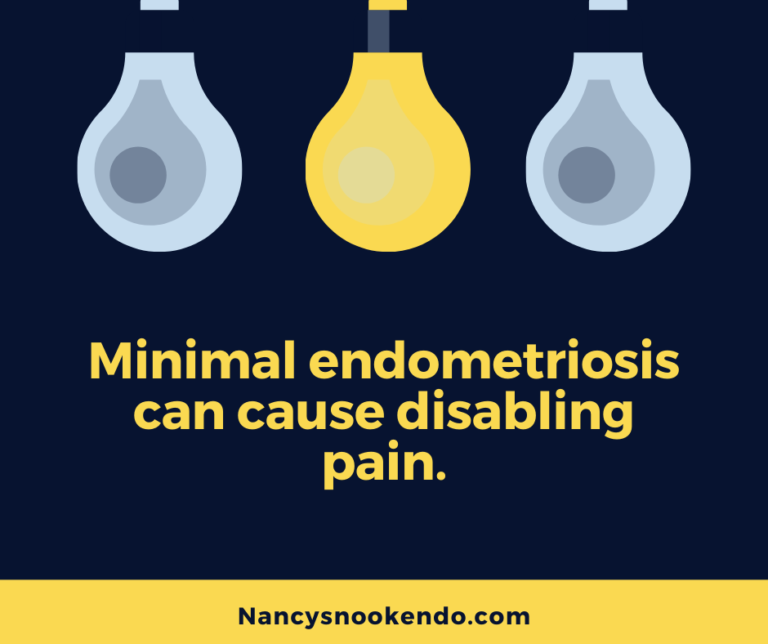By Nancy Petersen, RN, retired April 15, 2016 Updated 2020
ENDOMETRIOSIS: minimal disease can’t get no respect.
We have seen recently a move to discount minimal disease as not requiring surgical intervention. Rather the story goes, its minimal, use some suppressive meds and everything will be fine.
Multiple problems arise with this approach however. How do your rate disease as minimal? Symptoms? Pelvic exam? Guessing? Because if you do a laparoscope why would you not remove symptomatic disease? Then we start seeing the mythic belief that you can diagnose endometriosis by giving a dose of lupron or other suppressive drugs and if the patient gets better it must be endo. And lo and behold, you have already started treatment with the drug. However differentiating endometriosis response from ovarian response vs uterine response.
Not exactly. First of all no medication treats endometriosis. Suppressive drugs can alter hormonal states and quiet symptoms temporarily however disease can actually progress regardless.
So trying to use a drug to “diagnose” endometriosis is not scientific, or conclusive. Secondly drugs do not treat endo. And you have to assume it is “minimal disease” if you do not look via laparoscopy.
Anything else is a guess and the science of gynecology is not well served with guessing. Delaying removal of disease just exposes the patient to greater risk of infertility, progressive pain, and progressive injury to organs.
Staging disease via laparoscopy and then leaving the disease to be “cleaned up with drugs” also is off base. Drugs do not treat disease, staging has little to do with symptoms.
We know patients with minimal disease can have disabling pain and some patients with deeply infiltrating endometriosis can have no symptoms at all or minimal pain. Several in the field are now calling for using symptom profiles for assessing disease rather than amount of disease. Staging was developed for assessing fertility not really a tool for determining severity of endometriosis.
In any event we must begin to ask, why? Why would we leave disease behind, untreated, dismissed as minimal when the patients symptoms drove her to care? Why would we offer drugs known to not treat endo, instead altering the normal hormonal state to something else? Why would we dismiss the need to remove disease to eliminate symptoms?
Well I am not privy to the behind closed door decision making process but I can speculate with some degree of credibility having watched the field for 30 years.
First we don’t believe women and their pain. 75% of women in some surveys with endometriosis have been dismissed as neurotic. When we can get those women in to the hands of a skilled excision surgeon, most have active endometriosis. Secondly the marketing of drugs to doctors and the profit motives make it easy to set aside the true nature of a patient’s condition.
Thirdly MISOGYNY allows us to decide some disease just isn’t worth spending money on to do good surgery. It’s cheaper to throw a pill at a patient and say go home. As mentioned above when we do not believe 75% of our patients and their symptoms, it’s easy to be misled that we are doing effective care.
And lastly, I have to say I believe the lack of skill in recognizing (importance of understanding evolution of color appearance), locating (understanding the distribution of disease and how it correlates with symptoms) and removing disease tempts those treating it to avoid doing surgery and offer ineffective medical therapy instead of referring the patient elsewhere. Endometriosis surgery done well, is one of the more complex surgeries that have been developed to help patients and not many are trained in its fine points. Which may be why ablation is commonly done, as it is quick and easy however ineffective. Ablation keeps the OR door revolving as it is not a very effective approach.
We see a plethora of key factors to not to do surgery including adhesion formation (which often happens due to endometriosis in the pelvic creating inflammation and bleeding in the surrounding tissues) which is attributed to surgery. Some of that may be legitimate but leaving endometriosis and its inflammatory processes can contribute to an equal or greater degree. Saving ovarian reserve is also mentioned frequently. Meanwhile the patient will be exposed to GNRH agonists such as Lupron whose ovarian damage has been understated by the drug company, information held at bay by court ordered seal, and hidden as well by the FDA. The pessimistic view that endo always comes back is based in the lack of understanding of the true nature of the disease as well as the key factors mentioned above. In fact studies of Lupron by the drug company revealed that 60%+ of patients after being off Lupron for one year had not resumed ovarian function, an important finding for those trying to have families. However once noted, the drug company stopped following that data.
Minimal disease, how bad can it be? Well, peritoneal signs and symptoms should be able to give any care giver a clue. Bloating, pallor, nausea, rebound pain, poor quality sleep, pain with sex, pain with ovulation with periods, with exercise, with pelvic exams can all be severe with “minimal” disease. This coupled with loss of job, friends, spouses, self-esteem and social isolation, make this disease one of the most costly in all aspects of our lives. So if removing disease well can restore lives, why would we not do that?
This trend, folks is a value statement about women. Their pain cannot be that bad, they are hysterical, they cannot be having those symptoms, it’s too expensive to do surgery and on and on. Women and their endometriosis can’t get no respect.

